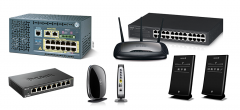Wireless PAN
Wireless LAN
- Wi-Fi: Wi-Fi is a commonly used wireless network in computer systems to enable connection to the internet or other devices that have Wi-Fi functionalities. Wi-Fi networks broadcast radio waves that can be picked up by Wi-Fi receivers attached to different computers or mobile phones.
- Fixed Wireless Data: This implements point to point links between computers or networks at two locations, often using dedicated microwave or laser beams over line of sight paths. It is often used in cities to connect networks in two or more buildings without physically wiring the buildings together.
Wireless MAN
Wireless Metropolitan area networks are a type of wireless network that connects several Wireless LANs.
- WiMAX is the term used to refer to wireless MANs and is covered in IEEE 802.16d/802.16e.
Mobile Device Networks
In recent decades with the development of smart phones, cellular telephone networks have been used to carry computer data in addition to telephone conversations:
- Global System for Mobile Communications (GSM): The GSM network is divided into three major systems: the switching system, the base station system, and the operation and support system. The cell phone connects to the base system station which then connects to the operation and support station; it then connects to the switching station where the call is transferred to where it needs to go. GSM is the most common standard and is used for a majority of cell phones.
- Personal Communications Service (PCS): PCS is a radio band that can be used by mobile phones in North America. Sprint happened to be the first service to set up a PCS.
- D-AMPS: D-AMPS, which stands for Digital Advanced Mobile Phone Service, is an upgraded version of AMPS but it is being phased out due to advancement in technology. The newer GSM networks are replacing the older system.










